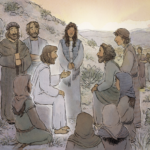[ad_1]
10 things you and your ministry can do to stop racism before it starts.
What will you do now to embrace the “people of every tribe and tongue and people and nation” that will worship God in heaven? Arm yourself to eliminate negative attitudes or messages in your ministry.
10 Things Your Ministry Can Do to Stop Racism Before It Starts
1. Begin young.
Most 2-year-olds notice skin color differences. If they also hear inappropriate comments about skin color, they may decide that different-color people aren’t as good as they are. Therefore, embrace and celebrate people of all colors.
2. Don’t ignore racial differences.
If children ask why a child’s skin is a different color, say something like, “Natasha’s skin is white because her mom and dad have white skin.” With older children, you can explain that the amount of melanin, the substance in the skin that accounts for color, determines the darkness of people’s skin.
Louise Derman-Sparks, author of Anti-Bias Curriculum: Tools for Empowering Young Children (National Association for the Education of Young Children), says we “can’t ignore [kids’] questions because kids make up their own theories, many of which are incorrect and can lead to prejudice.”
3. Don’t tolerate prejudice.
Forbid racial slurs or name-calling in your classroom. If you hear ethnic or racial insults, confront them at once.
ReGena Booze, a retired professor at Pacific Oaks College and Children’s School in Pasadena, California, says: “When a child in class, Rosa, was called a ‘yucky Mexican,’…I said to the children, ‘Yes, Rosa is Mexican, but yucky is not part of who she is. Let’s find out about her…Rosa’s family came from Mexico before she was born and her family can speak Spanish. So can Rosa. She’s very smart because she can speak two languages. But yucky is not a part of who Rosa is.”
4. Break down stereotypes.
A personal encounter with people of other races is the best way to break down stereotypes. Get kids working together in multiracial teams. Invite special guest speakers of all races to your classrooms.
5. Redecorate.
Examine your classrooms to discover any items that promote racial or cultural stereotypes. Do church pictures show Jesus with children of only one race? Replace these pictures with pictures of Jesus with children of all colors. Use multiracial dolls or only stuffed animals in your nurseries.
6. Examine your literature.
If your curriculum’s art doesn’t represent children of all colors, adapt it. If this segregated approach extends into the content, consider moving to a new curriculum. Ask these questions when examining your curriculum: Does it emphasize God’s inclusive love for all people? Are heroes in the modern-day stories diverse? Are there examples from everyday life from more than one culture?
7. Use multicultural activities.
You can include diversity in every part of your time with kids, from asking parents to provide snacks from their culture to regularly using different types of music for creative movement or during rest times. Infuse your craft time with multicultural crafts. Invite diversity into your class through the activities you choose.
8. Love is every person’s most basic need.
Whatever you do with kids and families, start and end with love. Ask yourself how you would feel while standing in their shoes. Would you feel welcome, seen, included, loved, and appreciated within the walls of your ministry?
“The first step is to help everyone understand God’s love and its power. Our love for Jesus is to be demonstrated by the way we love each other,” says John M. Perkins, founder of The John Perkins Center for reconciliation, leadership, training, and community development.
9. Treat people equally.
“Another way we can help overcome racism is to treat everyone with evenhandedness,” said Perkins. “A young teenager [who is from an ethnic minority] battled feelings of inferiority [due to race issues]. She was involved in our summer youth work program in Mississippi. After she came to Christ, she said: ‘I was amazed at how you loved me just as much as you loved the other children. That drew me to accept the love of Jesus.’ ”
10. Become secure in God’s love for you.
“A final way to overcome racism is to deal with our insecurities and help others deal with theirs. Insecurity causes one person to exploit another. If you do these things for every child in your ministry, you’ll affirm the dignity of people of all races,” Perkins said.
Looking for more teaching tips? Check out these ideas!
© Group Publishing, Inc. All rights reserved. No unauthorized use or duplication permitted.
[ad_2]
Source link







You must be logged in to post a comment.